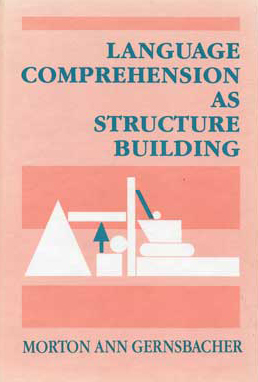 This book is the result of the author’s impressive research program on language comprehension. It describes her theory of discourse processing, the Structure Building Framework, and many innovative experiments supporting the Framework. Although introduced in the context of reading, the Structure Building Framework is a general theory of comprehension. The Framework emphasizes the processes that culminate in mental structures rather than the structures themselves. Gernsbacher introduces five cognitive processes that build structures representing clauses, sentences, and passages:
This book is the result of the author’s impressive research program on language comprehension. It describes her theory of discourse processing, the Structure Building Framework, and many innovative experiments supporting the Framework. Although introduced in the context of reading, the Structure Building Framework is a general theory of comprehension. The Framework emphasizes the processes that culminate in mental structures rather than the structures themselves. Gernsbacher introduces five cognitive processes that build structures representing clauses, sentences, and passages:
- The Process of Laying a Foundation
- The Process of Mapping
- The Process of Shifting
- The Enhancement Mechanism
- The Suppression Mechanism
First, the reader lays the foundation for the representation of the text, and then maps subsequent information to the growing structure or creates a new substructure depending on the similarity among the segments of the text. If the text is coherent, the reader maps the information on the existing structure. Otherwise she shifts to a new structure.
The Structure Building Framework has a neural flavor. The constituent elements of the mental structures are memory cells that have a base activation level, much like neurons do. The activation level depends on the coherence of incoming sentences. Once activated these cells remain active and activation spreads to similar cells, reflecting the process of enhancement. If information does not cohere with prior information, activation is dampened, reflecting the mechanism of suppression.
The three processes modulate the mental load, while the two mechanisms affect the level of activation of memory cells. Laying a foundation and shifting are resource consuming, they place a load on the cognitive processor and result in longer reading times. Mapping involves the integration of familiar content within existing structures; this process is easier and allows quicker reading and shorter reading times. Enhancement results in greater activation of memory cells and faster recognition speeds for the content in those structures. Suppression. on the other hand, reduces activation, making content less available, and slowing recognition speeds. The book has six chapters, including an introduction in Chapter 1 and a conclusion in Chapter 6. The second is devoted to the process of laying a foundation; the third chapter discusses the mapping and shifting processes; and the fourth chapter describes Gernsbacher’s research on the suppression and enhancement mechanisms. The fifth chapter examines individual differences in suppression and enhancement.
